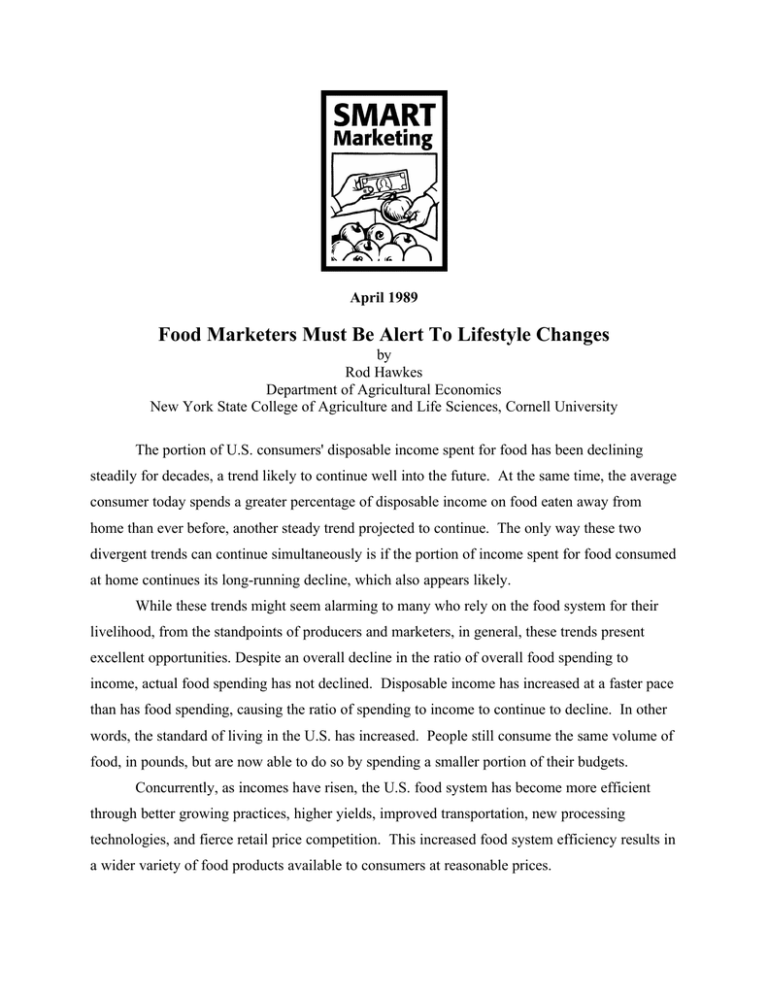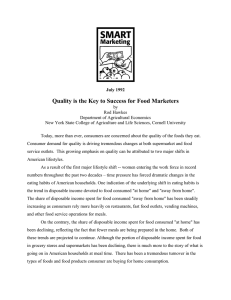Food Marketers Must Be Alert To Lifestyle Changes
advertisement

April 1989 Food Marketers Must Be Alert To Lifestyle Changes by Rod Hawkes Department of Agricultural Economics New York State College of Agriculture and Life Sciences, Cornell University The portion of U.S. consumers' disposable income spent for food has been declining steadily for decades, a trend likely to continue well into the future. At the same time, the average consumer today spends a greater percentage of disposable income on food eaten away from home than ever before, another steady trend projected to continue. The only way these two divergent trends can continue simultaneously is if the portion of income spent for food consumed at home continues its long-running decline, which also appears likely. While these trends might seem alarming to many who rely on the food system for their livelihood, from the standpoints of producers and marketers, in general, these trends present excellent opportunities. Despite an overall decline in the ratio of overall food spending to income, actual food spending has not declined. Disposable income has increased at a faster pace than has food spending, causing the ratio of spending to income to continue to decline. In other words, the standard of living in the U.S. has increased. People still consume the same volume of food, in pounds, but are now able to do so by spending a smaller portion of their budgets. Concurrently, as incomes have risen, the U.S. food system has become more efficient through better growing practices, higher yields, improved transportation, new processing technologies, and fierce retail price competition. This increased food system efficiency results in a wider variety of food products available to consumers at reasonable prices. The shift toward more food consumed away from home has also caused much concern among certain food system groups. But even for those most affected, wholesalers and retailers, this trend has presented considerable opportunities as these marketers have proven they can compete with fast-food restaurants for consumers' take-out food dollars. In fact, supermarkets actually have many marketing advantages (e.g. free in-store sampling of take-out foods and weekly advertising flyers) over fast-food outlets and are beginning to successfully exploit these points of difference. Producers may be concerned about this trend because their share of away-from-home food dollars is about half the farm value of food-at-home dollars. Again, these percentages can be deceiving because the price paid for potatoes by McDonalds is about the same price paid, generally, by supermarkets. The price paid by consumers for potatoes at MacDonalds, however, is much higher than the supermarket price because of the value added by food processing and preparation. Actually, the trend toward fast food might actually allow producers to market crops that do not meet retail quality standards for size or appearance. MacDonalds' french fries do not necessarily have to come from grade A potatoes because they are processed and prepared prior to consumption. Changing American lifestyles have produced changes in the types of food consumed and the form and location in which food is consumed. While consumption of some foods, such as beef, have declined, consumption of other foods, such as chicken, have increased. The net effect is little change in the total amount of food consumed, but big shifts in the composition of the American diet. These trends will continue as American lifestyles rely more heavily on convenience due to time pressures and emphasize more nutritious food due to heightened health awareness. Producers with foresight will readily see opportunities that develop from lifestyle changes, such as leaner meat products, fresh produce, new produce varieties (e.g. smaller watermelons for smaller households), more convenient farm-fresh foods (e.g. sliced carrots), and will be able to capitalize on the demand for such products and services.




